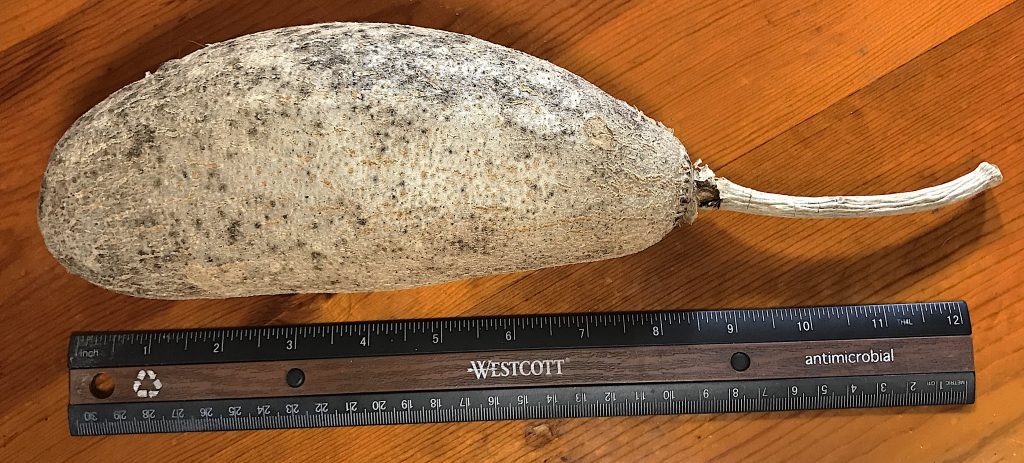
The chance discovery of a Cucumber Tree fruit. Photo by Green Deane
Foraging is treasure hunting for adults. It is also often a mystery. During a class in early October in West Palm Beach I saw the above fruit on the ground. I had no idea what it was but I tossed the hard thing into my trunk and embarked on the discovery of its identity.
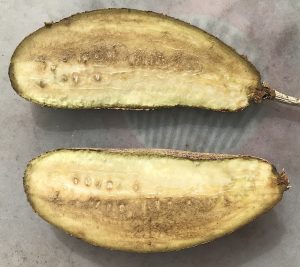
Cucumber Tree fruit is toxic but can be processed into edible. Photo by Green Deane
The first suggestion I got a Baobab fruit. It was a good contender. However, the Baobab tree is rather distinct and I did not recall seeing any tree in Dreher Park resembling the stout-trunked Baobab. It was not impossible, however, as five Baobabs reportedly grow nearby in Ft. Lauderdale and also in Miami. The Baobab fruit is described as cracking like a ripe coconut and loaded with seeds. This fruit did not crack like a coconut. In fact, it was hard to dent with a hammer. Cutting it required a cross-cut saw then a thick machette AND and hammer. It has seeds but not a huge amount of them. The next possibility made more sense: The Cucumber Tree or Sausage Tree, Kigelia africana. This worked because after finding some descriptions I knew exactly which tree the fruit came from. I had seen the tree in blossom before but had never seen it fruiting. What distinguishes the tree, as opposed to the trunk of the Baobab, is the blossoms which hang on six to 18 foot vines. On this particular tree the blossoms are a reddish maroon. The fruit is made edible by drying, roasting and or fermentation. It’s also used to make booze.
That there is such a tree in Dreher Park is not surprising. Paul Dreher, who developed the park, wasn’t given a budget for landscaping after the city bought the 108 acres for $100 in 1951. So, he scrounged around for species raiding discarded plant heaps, accepting vegetative donations, and getting specimens from hotels which back then were not restrained by landscape ordinances. This makes the species in the park quiet eclectic. Add the fact that it doesn’t freeze there too often and you have a park with an international array of plants.
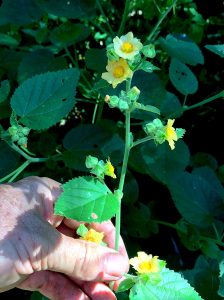
Sida cordifolia. Photo by Green Deane
Is it Sida (SEE-dah) or is it Sida (SIGH-dah)? Either either it would seem… There are several members of the Sida genus locally and they blossom nearly all year. This weekend, however, Sida cordifolia was particularly happy. Taller and softer than some of the other genusmates, it’s a plant with a little bit of legal history. Plants in the genus tend to have ephedrine in them to varying amounts. Sida cordifolia, however, is the only Sida species mentioned in the Florida Statutes. If you make a pill using the plant it cannot be given to anyone under the age of 18. I doubt the problem is bootleg diet pills but rather youthful experimenting with ephedrine. Adults can apparently do what they want with the plant. S. cordifolia is not native. The species I see the most often is S. rhombifolia, which means diamond shape. The lower part of the leaves of that speices do not have teeth on them. You can read more about Sida here.
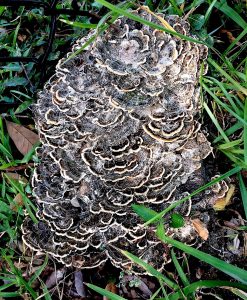
True Turkey Tails. Photo by Green Deane
And what of Turkey Tails? Turkey Tails are fairly easy to identify medicinal mushrooms. We spied some during a recent foraging class. For a common type of mushroom I don’t see them that often… two or three times a year. I see False Turkey Tails far more often. More on that later. A seven-year study funded by the National Institutes of Health found Turkey Tail (Trametes versicolor) boosted the immunity in women who had been treated for breast cancer. Researchers at the University of Minnesota and Bastyr University conducted the study in women with stages I-III breast cancer who had completed radiation therapy or chemotherapy. Results showed that immune function was enhanced in the women who took daily doses of Turkey Tail in pill form. They reported that the improved immune response was dose dependent and that none of the subjects suffered any adverse effects. Trametes versicolor can be chewed whole, eaten ground, or made into a tea, or a tincture. The question that always follows such comments is are False Turkey Tails, Stereum ostrea, medicinal? Informally one hears herbalists saying False Turkey Tails can be used but there are few specifics though it has a long herbalism history. A study in 2007 found that water extracts of Stereum ostrea were antibacterial and antifungal. That’s not cancer fighting or immune system stimulating but useful nonetheless. You can read that article here

Foraging classes are held rain or shine, heat or cold (hurricanes and tropical storms excepted.)Photo by Nermina Krenata
Staying reasonably close to home this weekend with foraging classes in Melbourne and Cassadaga. Melbourne has many coast community plants though the park is several miles from the ocean. Cassadaga is a nice location that surprisingly always draws a small class (so if you want more personal attention…)
Saturday October 26th, Wickham Park: 2500 Parkway Drive, Melbourne, FL 9 a.m. to noon. Meet at the dog park.
Sunday October 27th, Colby-Alderman Park: 1099 Massachusetts Street, Cassadaga, Fl., 9 a.m. to noon. Meet near the bathrooms.
Saturday Nov. 2nd, John Chestnut County Park: 2200 East Lake Road, Palm Harbor, FL 34685. 9 a.m. to noon. Meet at the beginning of the Peggy Park Trail inside the park.
Sunday, November 3rd, Mead Garden: 1500 S. Denning Dr., Winter Park, FL 32789. 9 a.m. to noon. Meet in the parking lot near the rest rooms.
Saturday November 9th Blanchard Park, 10501 Jay Blanchard Trail, Orlando, FL 32817. 9 a.m. to noon. Meet next to the tennis courts by the YMCA building.
Sunday, November 10th, Lake Woodruff National Wildlife Refuge, 2045 Mud Lake Road, DeLeon Springs, FL. 9 a.m. to noon. This class is rare because the federal property can be closed without notice. Meet at the first parking lot west of the railroad tracks.
Saturday, November 16th, Florida State College, south campus, 11901 Beach Blvd., Jacksonville, 32246. 9 a.m. to noon. We will meet at building “D” next to the administration parking lot.
Sunday, November 17th, Eagle Park Lake, 1800 Keene Road, Largo, FL 33771. 9 a.m. to noon. Meet at the pavilion by the dog park.
Saturday, November 23rd, Dreher Park, 1200 Southern Blvd., West Palm Beach, 33405. 9 a.m. to noon. Meet in the parking lot just north of the science center.
Sunday, November 24th, Bayshore Live Oak Park, Bayshore Drive. Port Charlotte. 9 a.m. to noon. Meet at the parking lot at the intersection of Bayshore Road and Ganyard Street. 9 a.m. to noon.
Saturday November 30th, Boulware Springs Park, 3420 SE 15th St., Gainesville, FL 32641. 9 a.m. to noon. Meet at the picnic tables next to the pump house.
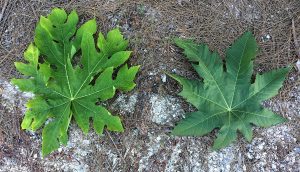
Papaya leaf on left, Castor Bean on right. Photo by Green Deane
Many botanical terms can be confusing among them palmate and pinnate. We’ll address pinnate another time. Palmate shouldn’t be difficult but it can be. It means ‘shaped like your hand’ but… there are small grape leaves that are “palmate” and about the size of an adult hand. Then there are palmate leaves that are a foot across. Here are two, one from the edible Papaya tree and the other from the deadly Castor Bean. The papaya leaf, on our left, is palmate with lobes. It has seven sections, seven main veins and two sections on the bottom. Stem attachment is on the edge. The Castor Bean, right side of the photo, is also palmate but has eight sections, the sections have teeth, eight main veins total, and three sections on the lower side. Stem attachment is not on the edge. There’s more about the Papaya here.
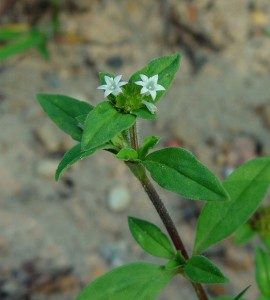
Richardia is generally not edible.
A plant that falls into the crack between edible and not edible is Richardia scabra, aka Florida Pusley. It’s in a genus that has species used to make you throw up. In fact one is called Richardia emetica. That is not encouraging. Some people mistake R. scabra for chickweed, which is a Stellaria, a totally different genus. The plants vaguely resemble each other if one ignores several details and that fact that real chickweed only grows here in the winter time. R. scabra is a species for which I have never found any ethnobotanical references to regarding edibility. In fact it is one of three common plants that seems to have either not been used by the natives or somehow were not reported. The other two are Amaranthus australis and Hibiscus moscheutos. I know from modern reports that A. australis is edible but as for the H. moscheutos I have no idea personally though it comes from a very edible genus and I hear it is edible. Thus R. scabra is not on my site as an edible because I can’t find any historical reference to its use. That said I know two people who mistook it for chickweed and ate it for quite a while. And I know two people who did not mistake it; they know it is a Richardia and they eat it from time to time. That might be a key element. Without any ethnobotanical reference perhaps a little now and then is okay but a steady diet of it is not. It is one of those unknown things.
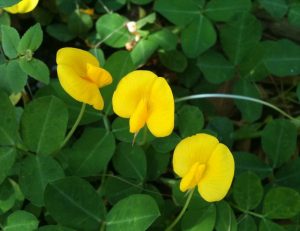
Perennial Peanut. The blossoms are edible.
I learned of this edible blossom from a chef who told me she ate them. That got my attention. Arachis glabrata, which botanists call by the spiffy name of Rhizoma Peanut, is also called Rhizomal Perennial Peanut, Perennial Forage Peanut, Golden Glory, and Ornamental Peanut Grass… none of them really catchy. It’s related closely to the peanut we eat, Arachis hypogaea (which by the way has edible stems and leaves, raw or cooked.) My first reference of choice, Cornucopia II, had nothing on the “Perennial Peanut” nor did my trusty standby, the Journal of Economic Botany. On-line, where I am loathe to do research unless absolutely necessary — I prefer books, libraries and universities — I turned up little. It is grazing fodder and native to Brazil. No mentions in English of humans eating it. But I did find a study in which researchers fed leaf powder to hens to see if it increased the intensity of yoke color. That can go both ways. It would seem reasonable they would not feed something toxic to hens for a product humans eat but they do exactly that with arsenic. That chemical is a disease preventative in chickens. So feeding hens Perennial Peanut leaf powder was no sign it was edible by humans. Finding no good sources I did what I have done many times in the compilation of this site: I wrote to one of the foraging study researchers, Benjamin Anderson, asking if he knew if humans could eat the plant. He wrote back. “Yes, I know that a lot of people eat the blossoms and they actually taste like peanuts. I have even heard of them being used in salads. Just be careful eating anything where there may have been chemicals sprayed, though.” I would call that a reliable source. The only caution I would add is that yellow blossoms eaten in quantities — regardless of the species — tend to be a laxative.
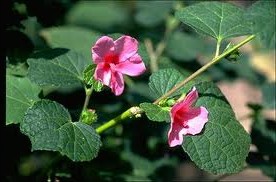
Ceasarweed’s name is a botanist’s joke.
Caesarweed is a common sight locally but right now it is being a seasonal extrovert and blossoming profusely. Like the Chinese Tallow tree above, Caesar Weed is another plant intentionally imported for industrial use, in its case making fiber for burlap bags and the like. It’s not strong enough to make a sturdy rope like edible Skunk Vine (which is also blossoming now and was imported to make rope.) But if thrown in water and allowed to rot for a few weeks long blast fibers are left over. The tasteless flowers are edible, the seeds can be ground and used like corn starch, and the leaves have medicinal uses besides being a famine food. They are hairy and upset the tummy. You can read about Caesar Weed here or see a video I did on it here.
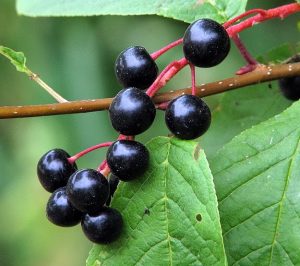
Do you know the Cossaboom Tree?
The study of plants is also the study of language. In my articles and classes I usually explain what the botanical name means. Sometimes that is helpful, sometimes it doesn’t add much (such as when both genus and species’ name are a person’s name.) Sometimes in English a person’s name can be helpful in the plant realm. I’ve made a side habit of collecting the meaning of surnames. I was reminded of that Sunday during a foraging class at Haul Over Canal on Merritt Island north of the space center. On the north end of the national refuge there is a Mirkwood Road. This road was there close to a century before The Hobbit became famous with its Mirkwood, which it said was “a forest of broad-leaf trees.” Mirkwood means “dark woods” or “border woods” and as a surname it comes through German into English as Marquard or “Mirk Guard” someone whose duty was to guard the border woods. “Kirkwood,” by the way, means “Church Woods” and Kildare “church of the oaks.” There are quite a few “woods” to explore. Where I grew up the largest dairy was Oakhurst which means a stand of oaks. One also saw Pinehurst Road and Elmhurst Lane. Oddly trees that famously produce a hurst usually aren’t called that such as Aspenhurst or Maplehurst though housing developers like them for street names. I say “persimmon hurst” now and then but only for effect. It is very rare to see a stand of persimmons but I do know of one persimmonhurst. I became interested in the meaning of surnames because I went to school with Longbottoms, Waterhouses, Toothachers, Weatheralls, Cossabooms, Granholms, Cheneys, Snodgrasses and Litchfields. The first four are not related to plants. They mean valley, castle with a mote, a place name in Switzerland and sheeps’ pen. But the rest have a botanical nuance. Here’s my list: Baumgartner (tree gardener) Birnbaum (pear tree) Cheney (oak grove) Cossaboom (cherry tree) Granholm (spruce island) Heywood (high woods) Lindbloom (lime flower) Linkletter (heather rock) Litchfield (gray woods) Maidenbaum (ginkgo tree or a young grafted tree) Mirkwood (boarder woods or dark woods) Olivenbaum (olive tree) Snodgrass (smooth grass) and Stubbs (stumps.)
 Donations: I had several site donations lately. Thank you. They were timely as WordPress went down for several days. The last 10 days had been a battle with Apple upgrades making some functions obsolete (which is how I am beginning to feel.) If anyone would like to donate to this website and newsletter they can use this Go Fund Me link, this PayPal donation link or by writing to Green Deane POB 941793 Maitland FL, 32794. Again, thank you.
Donations: I had several site donations lately. Thank you. They were timely as WordPress went down for several days. The last 10 days had been a battle with Apple upgrades making some functions obsolete (which is how I am beginning to feel.) If anyone would like to donate to this website and newsletter they can use this Go Fund Me link, this PayPal donation link or by writing to Green Deane POB 941793 Maitland FL, 32794. Again, thank you.

Foraging DVDs make a good gift to watch during the lifeless months of winter.
Foraging DVDs make a good gift to watch during the lifeless months of winter. All My Videos are available for free on You Tube. They do have ads on them so every time you watch a Green Deane video I get a quarter of one cent. Four views, one cent. Not exactly a large money-maker but it helps pays for this newsletter. If you want to see the videos without ads and some in slightly better quality you can order the DVD set. It is nine DVDs with 15 videos on each for a total of 135 videos. Many people want their own copy of the videos or they have a slow service and its easier to order then to watch them on-line. The DVDs make a good gift for that forager you know especially as spring is … springing. Individual DVDs can also be ordered or you can pick and choose. You can order them by clicking on the button on the top right hand side of this page (if your window is open wide enough.) Or you can go here.
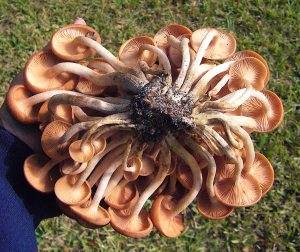
These prime Ringless Honey Mushrooms are cespitose, all growing out of one spot. Photo by Green Deane
Do you recognize the edible mushroom species on the left? If you read the Green Deane Forum you would. They’re flushing now… not the site but the mushrooms. Perhaps you’re looking for a foraging reference? You might have a UFO, an Unidentified Flowering Object you want identified. On the Green Deane Forum we — including Green Deane and some 8,000 others from around the world — chat about foraging all year. And it’s not just about warm-weather plants or just North American flora. Many nations share common weeds so there’s a lot to talk about. There’s also more than weeds. The reference section has information for foraging around the world. There are also articles on food preservation, and forgotten skills from making bows to fermenting food.
This is weekly newsletter 377. If you want to subscribe to this free newsletter you can find the sign-up form in the menu at the top of the page.


A lot of very useful
Information!
Wow! All the newsletters rock but this one REALLY was good! Lots of pertinent info towards what I’m looking at right now!